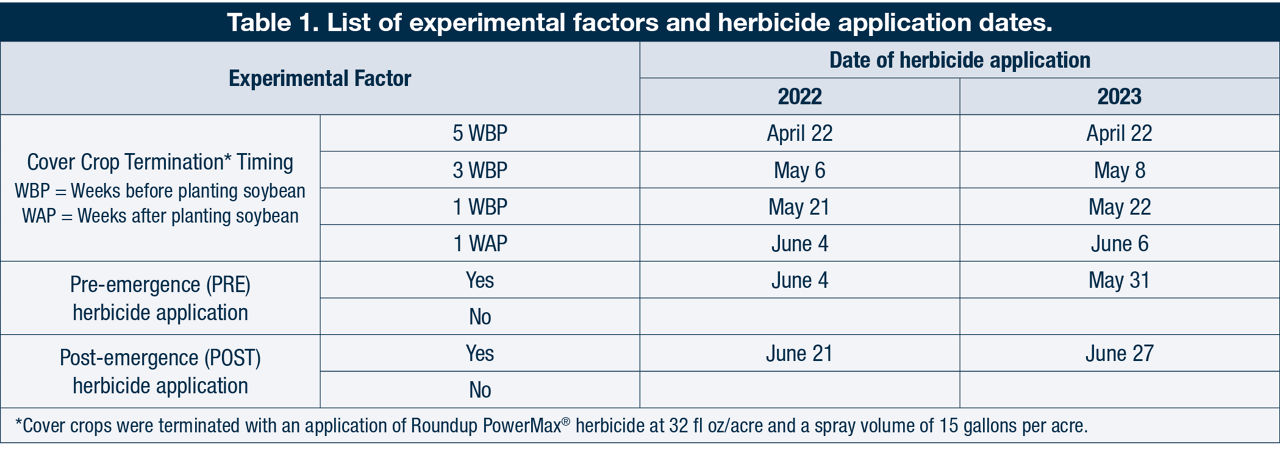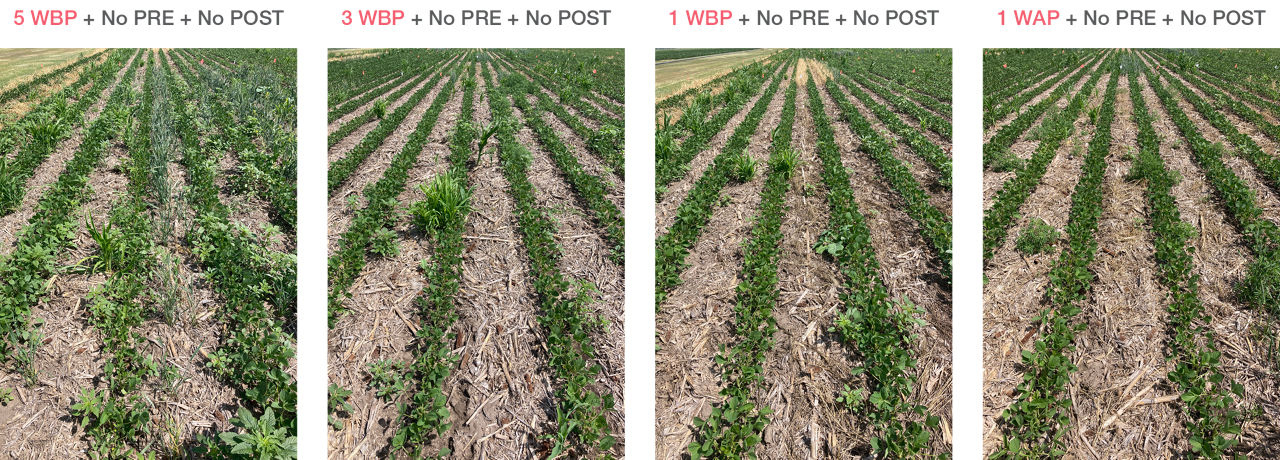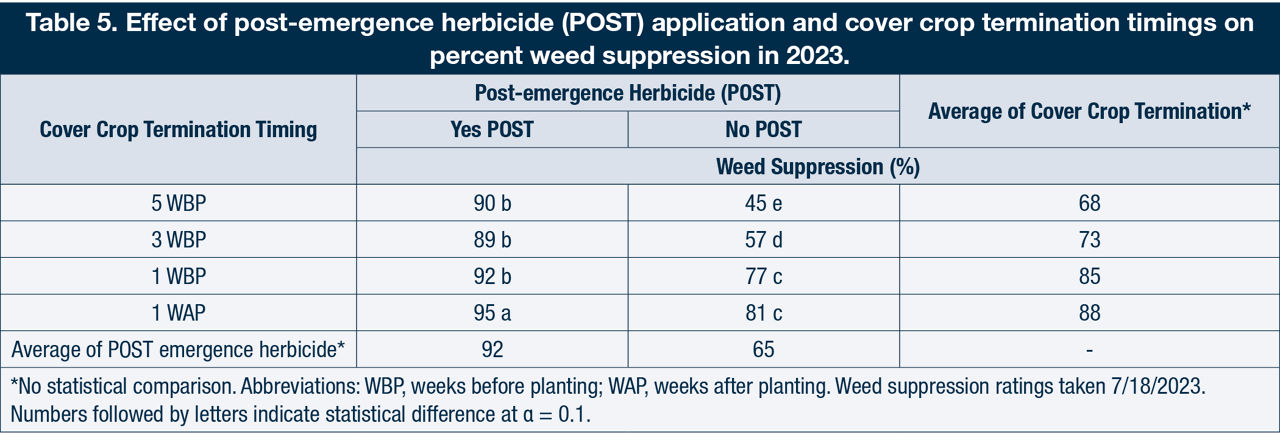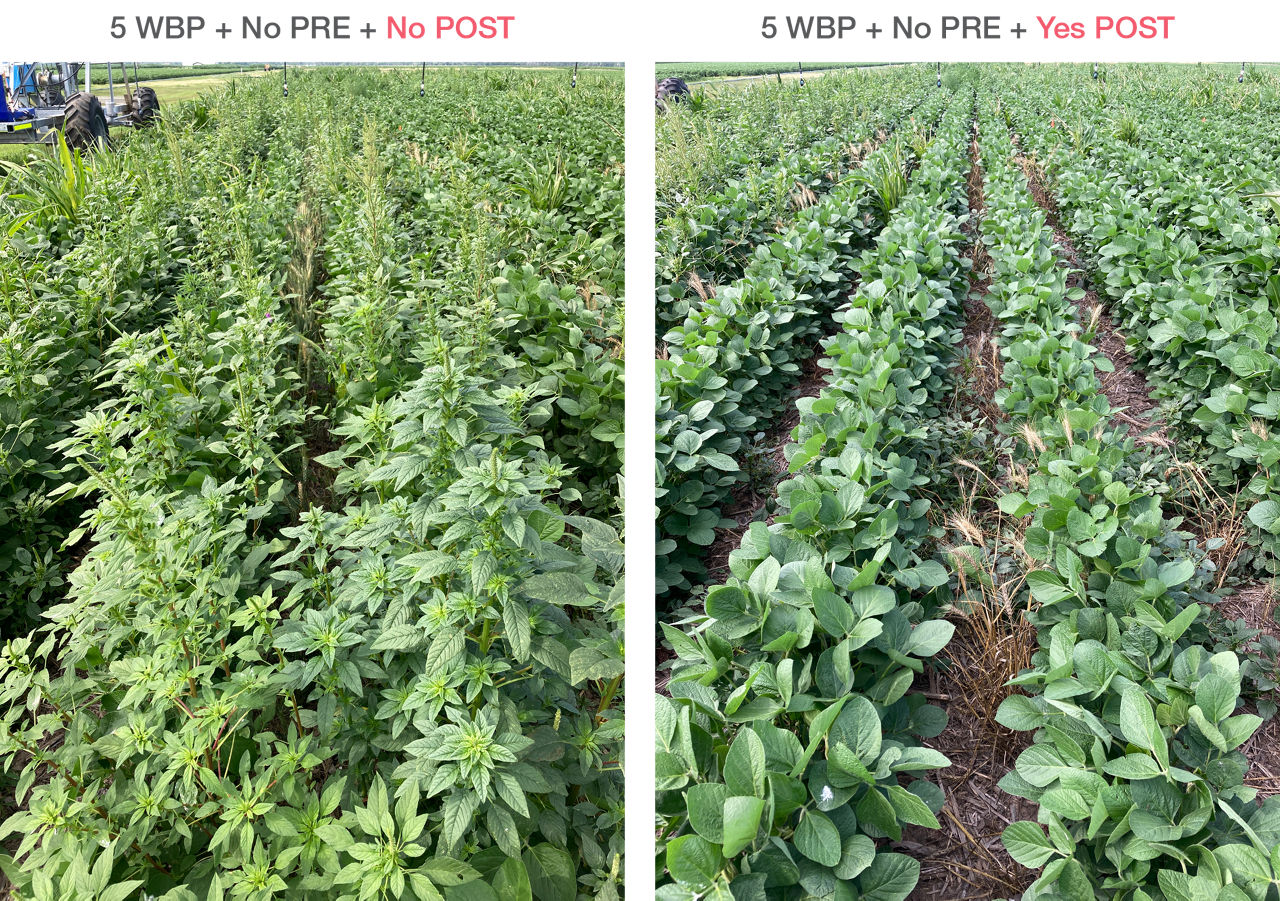Cover Crop Management and Herbicide Program Selection Impact on Weed Suppression and Soybean Yields
April 24, 2024
TRIAL OBJECTIVE
- To suppress troublesome weeds, farmers may need to consider all possible tools available to them. While herbicides have a long history of effective weed suppression, cover crops have the potential to add value by competing with weeds.
- The objective of this study was to evaluate the combination of cover crops with pre- and post-emergence herbicides in suppressing weed populations and the potential impact on soybean yield.
RESEARCH SITE DETAILS

- The trial design was a randomized complete block with four replications and three treatment factors (Table 1):

- Field operations, seeding rates for cover crops and soybean, fertilizer nutrients and application rates, and the amount of irrigation water applied are listed in Table 2:

- The pre-emergence (PRE) and post-emergence (POST) herbicide programs used in this study are presented in Table 3:

- Weed suppression for the pre-emergence (PRE) herbicide treatments (Figure 2) was evaluated at 17 days after treatment (DAT) on 6/21/2022 and at 25 DAT on 6/25/2023.
- The post-emergence (POST) herbicide treatments were evaluated for weed suppression on 7/8/2022 (17 DAT) and at 21 DAT on 7/18/2023 (Figure 3).
- After weed suppression evaluations, weeds were removed by hand to facilitate soybean harvest.
- The study was machine harvested with a plot combine. The moisture content, test weight, and total weight of the grain was collected using the combine.
- Statistical analysis for Fisher’s Least Significant Difference (LSD) was performed.
UNDERSTANDING THE RESULTS
- The most prevalent weeds during the growing season were Palmer amaranth (Amaranthus palmeri) and kochia (Bassia scoparia). Volunteer corn pressure was high.
- Pre-emergence (PRE) herbicides provided good control of volunteer corn. However, control of volunteer corn due to the cover crop was minimal (data not presented).
- Cover crops terminated at 5 WBP had minimal plant growth and were essentially equal to not having a cover crop present at all.


- Cover crops terminated one week after planting soybean (1 WAP) resulted in 95% weed suppression compared to 90%, 76%, and 71% for the 1 WBP, 3 WBP, and 5 WBP treatments, respectively (Table 4 and Figure 1).
- Averaged across cover crop termination timings, pre-emergence herbicide application (Yes PRE) provided 93% weed suppression compared to 73% without a pre-emergence herbicide (No PRE) treatment (Table 4 and Figure 2).
- Cover crop termination at 1 WAP combined with pre-emergence herbicide (Yes PRE) application had slightly improved weed suppression (96%) compared to the 1 WAP + No PRE (93%) and 1 WBP + Yes PRE (94%) treatments. Weed suppression resulting from the combination of 1 WAP + with PRE herbicide was statistically higher than all other treatment combinations (Table 4). Cover crops terminated at 5 WBP without pre-emergence (No PRE) herbicide resulted in the least amount of weed suppression (Table 4).


- Averaged across cover crop termination timings, the post-emergence herbicide application (Yes POST) provided 92% weed suppression compared to 65% without a POST treatment applied (No POST, Table 5 and Figure 3).
- Terminating the cover crop one week after planting soybeans (1 WAP) resulted in 88% weed suppression compared to 85%, 73%, and 68% for the 1 WBP, 3 WBP, and 5 WBP treatments, respectively (Table 5).
- Cover crop termination at 1 WAP combined with post-emergence herbicide (Yes POST) application resulted in the highest weed suppression (95%) among all treatments. Cover crops terminated 5 WBP without post-emergence herbicide (No POST) had 45% weed suppression, the lowest among all treatments (Table 5).


- The post-emergence herbicide application treatment (Yes POST) resulted in 89% weed suppression; however, it was significantly increased to 94% when the Yes POST treatment was combined with the pre-emergence (Yes PRE) herbicide treatment (Table 6).
- The POST and PRE herbicide treatments alone are not a fair comparison because of the timing of the weed suppression ratings between the two years of the study. Weed suppression was evaluated at 32 and 48 days after PRE herbicide application in 2022 and 2023, respectively. Weed suppression ratings for the POST herbicide treatments were taken at 17 and 21 days after POST application in 2022 and 2023, respectively (Table 6).

- The PRE and POST emergence herbicide alone, and in combination, had significantly (α = 0.1) higher yields compared to no herbicide application (Figure 4).
KEY LEARNINGS
- Cover crops did not influence soybean yields (data not presented); however, they had key participation in suppressing weeds in this study.
- Post-emergence herbicides were successful in suppressing weeds and achieving higher soybean yields, especially when combined with pre-emergence herbicides.
- The treatment combining pre-emergence and post-emergence herbicides enhanced weed suppression compared to the use of either treatment alone.
- Cover crop termination within 1 week before or after soybean planting increased percent weed suppression compared to termination taking place at 3 or 5 weeks before planting.
- Cover crops function as a weed management tool and are a valuable resource when suppressing herbicide-resistant weeds.
1310_377150
Seed Brands & Traits
Crop Protection
Disclaimer
Always read and follow pesticide label directions, insect resistance management requirements (where applicable), and grain marketing and all other stewardship practices.
©2024 Bayer Group. All rights reserved.